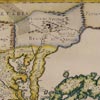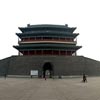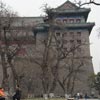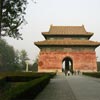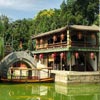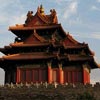Ming and Qing period
15:00 19-1-2010 Peking Culture
In 1368, Zhu Yuanzhang, soon after declaring himself the first emperor of the Ming Dynasty, sent an army toward Dadu, still held by the Yuan. The last Yuan emperor fled north to Shangdu, and Zhu razed the Yuan palaces in Dadu to the ground.[25] The city was renamed Beiping (北平), or "northern peace" in the same year,[26] and Shuntian (順天) prefecture was established in the area around the city.[27] In 1403, the new (and third) Ming emperor - the Yongle Emperor - renamed this city Beijing (北京), or "northern capital",[26] and designated Beijing the co-capital alongside the (then) current capital of Nanjing. Beijing was the subject of a major construction project for a new Imperial residence, the Forbidden City that lasted nearly 15 years (1406 to 1420).[22] When the palace was finished, the Yongle Emperor ceremoniously took up residence. From 1421 onwards, Beijing, also known as Jingshi (京师),[26] was the "official" capital of the Ming Dynasty while Nanjing was demoted to the status of "secondary" capital. This system of dual capitals (with Beijing being vastly more important) continued for the duration of the Ming Dynasty. Thirteen of the sixteen Ming Emperors are buried in elaborate tombs near Beijing.
By the 15th century, Beijing had essentially taken its current shape, and the Ming-era city wall served as the Beijing city wall until modern times, when it was pulled down and the 2nd Ring Road was built in its place.[28] It is believed that Beijing was the largest city in the world from 1425 to 1650 and from 1710 to 1825.[29] Other notable buildings constructed during the Ming period include the Temple of Heaven (built by 1420).[30] The Tiananmen Gate, now a state symbol of the People's Republic of China and featured on its emblem, was first built in 1420, and rebuilt several times later. Tiananmen Square was built in 1651 and enlarged in 1958.[31] Jesuits finished building the first Beijing-area Roman Catholic church in 1652 at the Xuanwu Gate, where Italian Jesuit Matteo Ricci (1552–1610) had lived; the modern Nantang (南堂, Southern Cathedral) has been built over the original cathedral.
The end of the Ming came in 1644 when, for 40 days, Li Zicheng's peasant army captured Beijing and overthrew the Ming government. When the powerful Manchu army arrived at the outskirts of the city, Li and his followers abandoned the city and as a result the Manchu forces, under Prince Dorgon, captured Beijing without a fight.
Prince Dorgon established the Qing Dynasty as a direct successor to the Ming, and Beijing remained China's capital.[33] The Qing Emperors made some modifications to the Imperial residence, but in large part, the Ming buildings and the general layout remained unchanged. Beijing at this time was also known as Jingshi, which corresponded to the Manchu Gemun Hecen with the same meaning.[34] The classic Chinese novel Dream of the Red Chamber is set in Beijing during the early years of Qing rule (the end of the 1600s).
At the end of Qing period, Beijing was the scene of the siege of the foreign legations during the Boxer Rebellion in 1900.[35] Some important Imperial structures in the city were destroyed during the fighting, including the Hanlin Academy and Summer Palace.


